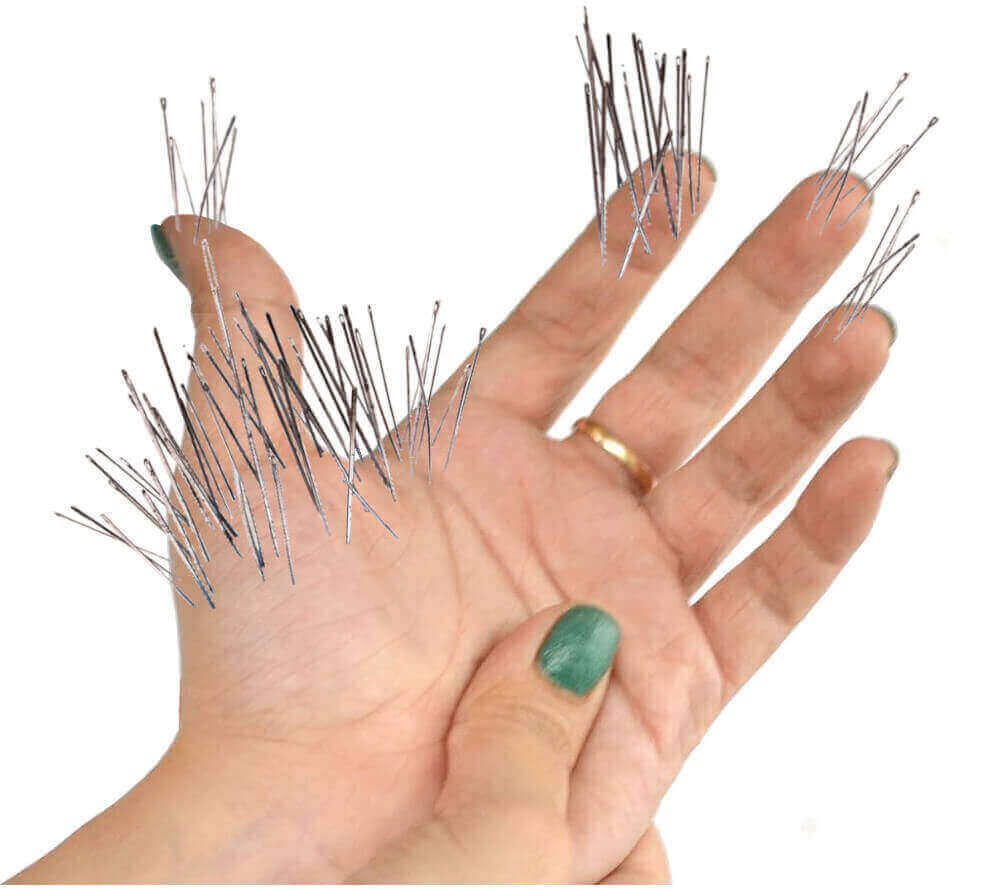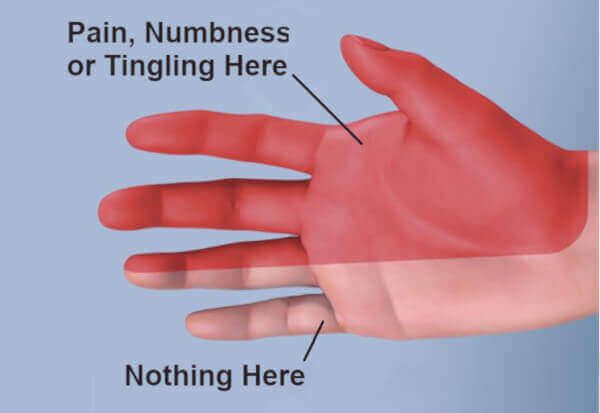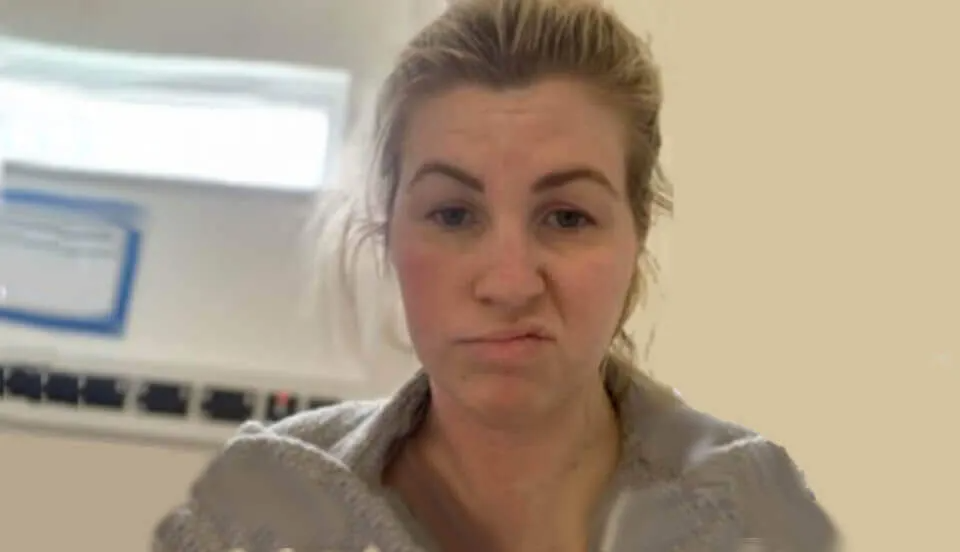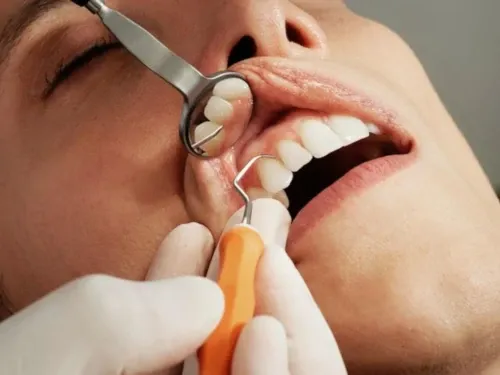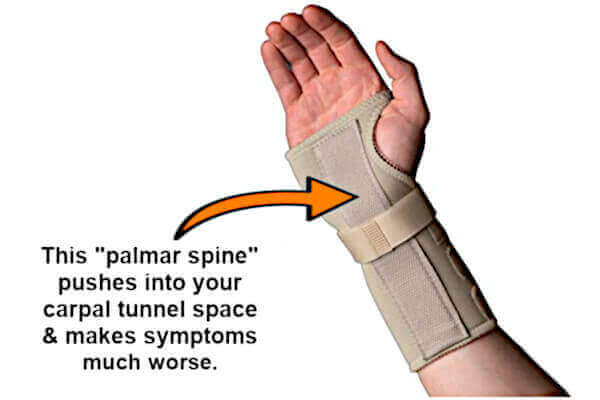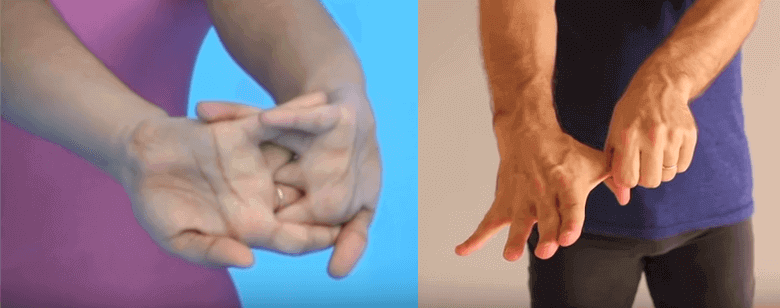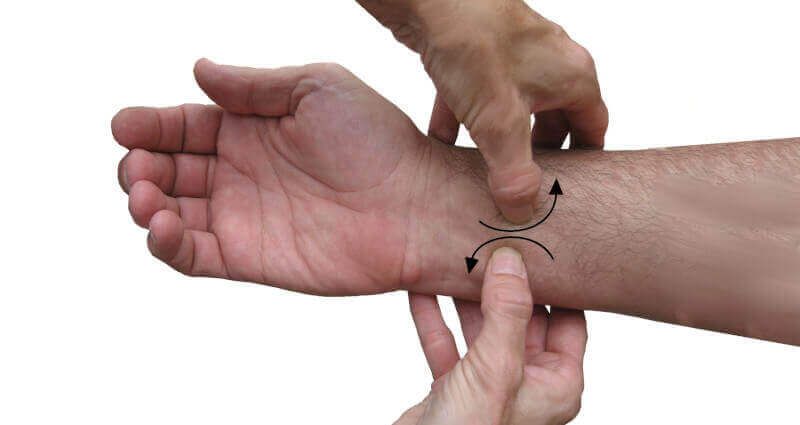Checklist: What Carpal Tunnel Symptoms Feel Like
From Dr. Z - Carpal tunnel syndrome specialist
What Carpal Tunnel Symptoms Feel Like
Here's what carpal tunnel symptoms feel like: you can expect problems in your hand and fingers. These problems can be one or more of the following:
- numbness
- pain
- tingling ("pins-and-needles")
- weakness
- shooting electric shocks
- itchiness
- puffy feelings in the finger or hand
- finger clumsiness
- hand weakness
These symptoms are usually worse in the thumb and forefinger. But the little finger is never involved.
Symptoms start off being merely bothersome at night, while you're trying to sleep. But as carpal tunnel advances, it begins to show up in the daytime as well.
Continue reading to learn what else to look for if you have this progressive disorder.
When do carpal tunnel symptoms occur?
When the condition starts out
Most people find it hard to tell when their carpal tunnel symptoms first began. The reason is because it usually starts off very subtly, with little fanfare.
The most common symptoms at the beginning of this disorder are:
- pain
- numbness
- tingling ("pins-and-needles")
- soreness
- itchiness
- burning
- shooting electric shocks
In fact, you may not even notice symptoms at all. Usually, you're trying to sleep but numbness or pain wakes you up. You try to shake out the numbness or rub out the pain. That usually helps a little. Perhaps hanging your hand over the bed also helps.
In time, these mild stage "bothersome" symptoms start to worsen. They keep you from having a restful night. This means carpal tunnel syndrome is starting to enter a more severe stage.
This next stage of the disorder is when symptoms appear during the daytime. The condition has definitely worsened. Moreover, it's very likely going to continue to worsen if you don't take measures now to stop it.
As a general rule, the signs & symptoms of carpal tunnel syndrome start off subtly. They appear only when your hand is at rest, like when sleeping or relaxing. As it progresses, the symptoms persist throughout the daytime.
Daytime carpal tunnel symptoms come on so gradually that you think it's due to overworking your fingers or hand. For example, many patients feel their hands hurting or go numb while driving a car. They usually attribute it to driving too long or gripping the steering wheel too tightly.
Some people feel numbness when talking on a phone. If they put their hands to their sides, the numbness subsides.
Some professionals, like hairdressers, transcriptionists, musicians, gamers, graphic artists, and dental hygienists feel symptoms during their working hours. They usually attribute it to to overly stressing their hands.
But they soon realize the symptoms are worsening every week. This means carpal tunnel syndrome is progressing to the severe stage.
As the condition worsens
The severity of the condition does not depend on what carpal tunnel symptoms you have. Rather, it's when they appear. If symptoms are present during the daytime, your disorder is considered more advanced.
In the beginning you may have had one or two symptoms (finger numbness and tingling are common). But with progression into more severe stages, other symptoms usually enter the picture. They usually include pain, numbness and tingling. But patients commonly feel one or more of the following symptoms as well:
- weakness and loss of grip strength
- loss of hot or cold sensations
- loss of dexterity (severe clumsiness)
- feelings of puffy fingers or hand
Along with these other sensations, the original pain, numbness or tingling will be much more intense. Symptoms will also be persistent, lasting all day and night.
What causes carpal tunnel syndrome?
Nobody is sure what carpal tunnel symptoms are caused by. You can analyze two different people with similar physical characteristics and occupations. But one might have carpal tunnel syndrome whereas the other does not.
However, the National Institutes of Health says there is a definite link between carpal tunnel syndrome and certain "risk factors". These are:
- Having an occupation that puts you at risk. Such occupations usually require using your fingers and hands for rapid and repetitive or forceful activity.
- Women are
several times more likely to have carpal tunnel syndrome.
- Having a family history of the disorder means you're at high risk if a close family member has/had the disorder.
- You're at high risk if you have Type II diabetes.
- Being pregnant (especially in the third trimester) means you tend to retain fluids. This is a perfect set-up for getting carpal tunnel syndrome.
- You're at high risk if you have rheumatoid arthritis.
- People with thyroid problems also are at high risk.
- Having a wrist trauma (like a sprain or fracture) or a wrist cyst elevates you to the high risk category.
- Women in menopause tend to retain retain fluids, and this causes conditions ripe for carpal tunnel.
- Obesity is a major risk factor for having carpal tunnel syndrome.
- High blood pressure puts you at high risk.
- Emotionally stressed individuals are at high risk.
- Persons with a small body frame are at high risk due to the small diameter of the wrist joint.
How to treat carpal tunnel
No matter what carpal tunnel symptoms make you miserable, treatment options will be identical. There are two such options:
- Surgical
Surgical options are usually reserved only for patients experiencing extreme or intense symptoms. In fact, the American Academy of Orthopedic Surgeons (who license and regulate hand surgeons) say that surgery should only be performed in cases of severe carpal tunnel syndrome. Everyone else must first try non-surgical remedies for at least 6 months. - Non-surgical
The non-surgical options available usually eliminate symptoms is over 90% of patients. They are by far the most commonly used treatment options. These options are most effective when two or three of them are used simultaneously.
Surgical options for carpal tunnel syndrome
Surgery for carpal tunnel syndrome is called carpal tunnel release surgery. It can be performed using one of two procedures. Each procedure has its own pros and cons you can learn more about here. Generally, the procedures are divided into:
- Open carpal tunnel release surgery
- Endoscopic carpal tunnel release surgery
The success rate of each surgical procedure is approximately the same: about 50%. The success is measured at year 2 or 3. This is where about half of patients are satisfied with their results, while the other half are not. The most common reason for dissatisfaction or unsuccessful results is return of symptoms.
Open carpal tunnel release surgery
In the procedure known as open carpal tunnel release surgery, the doctor creates a 2-3 inch long incision in your palm. The doctor then cuts the transverse carpal ligament to relieve symptoms.
There is a 1-4 month recovery period (compared to just a few weeks with the endoscopic procedure). Also compared to the endoscopic procedure, the open procedure results in greater post-surgical pain. This means more extensive aftercare and rehabilitation are required.
The biggest advantage of the open procedure is it usually results in fewer complications compared to the endoscopic procedure. Such complications include excessive bleeding and nerve or blood vessel damage.
Endoscopic carpal tunnel release surgery
Endoscopic carpal tunnel release surgery also aims to relieve symptoms by cutting the transverse carpal ligament. However, it's all performed through an endoscope. This require a small slit in your wrist (and sometimes another in your palm) to insert the instruments needed to cut the ligament.
The recovery period and aftercare is much shorter, lasting just a few weeks. Post-surgical pain is significantly less. And the size of the surgical scar is greatly reduced.
But the main disadvantage of the endoscopic procedure is the higher complication rate. The reason for the higher complication rate is due to the reduced visual field offered by the endoscope. That means there's a greater chance the doctor can accidentally cutting a vital structure, like a nerve.
Non-surgical options for carpal tunnel syndrome
The National Institute of Health says in general, non-surgical options are at least as effective as carpal tunnel release surgery. And unlike surgery, there is no risk involved in using non-surgical remedies.
What carpal tunnel symptoms respond to best is reduction of inflammation and swelling. That's why the following non-surgical remedies are so popular (and effective):
- Steroid injections (steroid shots)
- Nocturnal wrist bracing
- Stretching exercises
- Myofascial release massage
Steroid injections
All good carpal tunnel treatments aim to reduce pressure and swelling inside the carpal tunnel space of the wrist joint. Surgery does so by cutting the transverse carpal ligament, thereby reducing pressure on the median nerve. Steroid injections target the inflammation directly because they use the anti-inflammatory drug, cortisone.
Cortisone is a well-known inflammation reducer. This is why it works in carpal tunnel syndrome. An injection into the wrist reduces swelling which in turn, eases symptoms.
When the injection works, it works well. Symptoms typically take 1-2 weeks to disappear. But they normally return within 6 months.
However, in about 45% of patients the injection doesn't help at all. Nobody is certain why this happens.
Finally, there are specific risks of steroid injections such as s excessive bone loss and weight gain. This is why you can only have a couple injections per year, and only a few per lifetime. For these reasons, steroid injections are not a very good option for the long-term elimination of carpal tunnel symptoms.
Nocturnal bracing
One of the least expensive and most effective remedies for carpal tunnel syndrome is nocturnal (night) bracing. Wearing a brace while you sleep performs two key functions:
- First, a brace allows your hand to fully
rest as you sleep. Rest lets the body heal the damaged tissues inside the wrist joint, which is the source of the problem.
- Second, a night brace keeps you from unconsciously over-bending your wrist. Everybody bends their wrist while sleeping. But such bending can cause more pressure inside the wrist joint. This is very harmful if you already have carpal tunnel syndrome. A brace guards against that.
How & when to wear a brace
From my experience, the vast majority of people with carpal tunnel syndrome wear a wrist brace improperly. They actually do more harm to their wrist (and to their carpal tunnel syndrome) than if they just left their wrist alone.
Here are the 2 rules to wearing a brace to help (not hurt) your condition:
- Only wear a wrist brace at night, and
never
during the day. If you have carpal tunnel, your wrist is already injured. Adding a brace to it during the day forces your wrist to fight the brace in addition to doing it's regular work. This further stresses your wrist and makes the condition worse.
- Do not wear "pharmacy braces" typically sold at Walmart, CVS, Walgreens, Rite Aid. They might say "good for carpal tunnel syndrome" but they're not. That's because they all have a palmar spine (see illustration above). That spine pushes into your wrist joint, increasing pressure and making symptoms worse in the morning. But a certified carpal tunnel brace has no such palmar spine. It should be the only brace worn at night.
Stretching exercises
I believe that stretching exercises have some of the greatest positive effects on carpal tunnel syndrome. That's because they can prevent it from happening as well as make make ongoing symptoms disappear forever. Also, you can do the exercises almost anywhere and any time.
As with other effective remedies, the key is to reduce inflammation and swelling in your wrist joint. Most times, this swelling is due to inflamed tendons. But stretching exercises make tendons more supple. This allows the to glide more smoothly. The result is healthy tendons that don't inflame and cause problems.
The most beneficial stretching exercises concentrate on the flexor tendons. These are the structures responsible for causing inflammation.
It's most effective to perform the exercises as often as possible - hourly is optimal. They're designed to be fast and simple to do (taking literally less than a minute to complete). This means they won't interfere with your daily activities.
After a month of stretching exercises combined with nocturnal bracing and massage (below), most patients see their symptoms radically improve.
Myofascial release massage
Along with stretching exercises, no other therapy has as much impact on carpal tunnel symptoms as myofascial release massage.
Like stretching exercises, it concentrates on inflamed flexor tendons inside your wrist joint. Myofascial release massage is not a typical massage like Swedish massage or shiatsu massage. Instead, it produces a localized kneading motion on the skin surface. This transmits downward, to the tendons beneath.
The kneading action breaks apart adhesions that form on tendons. The adhesions reduce suppleness which leads to inflammation and swelling. But the kneading motion of myofascial release massage pulls apart the adhesions, even at deeper tendon levels.
When performed every day for about 4 weeks, myofascial release massage will eliminate most of the symptoms of carpal tunnel syndrome. When used in combination with nocturnal bracing and stretching exercises, most patients see complete resolution of symptoms - even at the most severe stages of the disorder.
Conclusion
No matter what carpal tunnel symptoms you have, there are basically 2 choices to treat the condition: surgery or non-surgical therapies.
Surgery is a radical and invasive process. It also has significant pros and cons.
Non-surgical therapies are less radical, yet offer the same effectiveness rate. They include steroid injections, nocturnal bracing, stretching exercises, and myofascial release massage.


